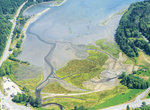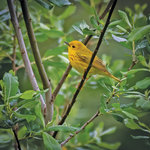

Jefferson County was awarded $1.2 million from the state’s Department of Ecology to conserve critical wetland and watershed areas along the county’s coastlines.
The state Department of Ecology announced April 13 it secured seven National Coastal Wetlands Conservation grants worth $5 million to help local partners restore coastal wetlands and 17,500 feet of marine shoreline in Jefferson, Kistap, Snohomish, Thurston and Whatcom counties.
Jefferson County will receive $1.2 million from these federal grants for two separate projects: $713,268 for a major conservation project in Discovery Bay and another $508,000 to protect and restore 14.5 acres of wetlands along Tarboo Creek.
Discovery Bay project
The Discovery Bay project is a partnership with the Jefferson Land Trust and the North Olympic Salmon Coalition to acquire and conserve 9 acres of wetlands and nearshore habitat in Discovery Bay and nearly 2,173 feet of Puget Sound shoreline.
Discovery Bay features current and historic estuarine salt marsh habitat, freshwater marsh, sand spit, tide flats, tidal channels and the mouth of a fish-bearing stream.
These areas provide critical habitat for federally listed salmon species such as summer chum, coho and steelhead salmon, as well as other fish and wildlife species, such as Olympia oysters, forage fish and migratory shorebirds.
The Jefferson Land Trust is one of many partners—including NOSC, the county’s Marine Resources Committee, the Jamestown S’Klallam Tribe and others—that has been protecting and restoring land at Discovery Bay since 2002.
“The beauty of this is we have such a great collaborative spirit here,” said Sarah Spaeth, conservation director at the Jefferson Land Trust. “It takes all of us doing what we do best to make these projects successful.”
This newest project is building on a history of acquiring land to permanently protect it.
The plan is to conserve degraded and filled estuary and nearshore habitats. It will also preserve a rare pocket estuary that provides salt marsh habitat in Discovery Bay.
Salt marshes are coastal wetlands that are flooded and drained by salt water brought in by the tides. According to the National Ocean Service, these intertidal habitats are essential for healthy fisheries, coastlines and communities.
According to the Department of Ecology, wetlands that border Puget Sound can be among the most complex, productive ecosystems in the world, rivaling the planet’s rain forests and coral reefs.
These lands support endangered Southern Resident orca whales and other marine mammals, salmon, forage fish, shellfish, waterfowl and shorebirds, as well as plant species.
Wetlands also help mitigate climate change by absorbing greenhouse gasses, protecting water quality, reducing flooding and recharging drinking water aquifers.
Tarboo Creek project
Along Tarboo Creek, the Department of Ecology will partner with the Northwest Watershed Institute to permanently protect and restore 14.5 acres of wetlands on three adjoining parcels along the creek that drain into Tarboo-Dabob Bay and Puget Sound.
Much of the $500,000 will go to acquire the three parcels. The restoration aspect will include removing structures and wetland fill from two properties. It will also include revegetating the property to restore the unique forest and scrub-shrub wetlands.
The Northwest Watershed Institute has led a restoration project in the Tarboo Watershed since 2002. The organization has already protected more than 2,200 acres within the Dabob Bay Natural Area and more than 500 acres of streams and wetlands, removed 12 road culverts to restore access for fish-bearing streams and planted 90,000 native trees and shrubs along Tarboo Creek.
“This is an important piece of the larger Tarboo Creek stream corridor that we’re trying to protect and restore,” said Peter Bahls, director of the Northwest Watershed Institute.
The freshwater wetlands and streams provide habitat for at-risk species, including rearing and spawning habitat for endangered steelhead and coho salmon, coastal cutthroat trout and Western brook lamprey.
Many forest and scrub-shrub freshwater wetlands like the ones found surrounding Tarboo Creek were converted to agricultural land over the years.
“These are nationally declining wetland types,” Bahls said. “They serve extremely important functions for the environment as a whole, including keeping the water quality clean, which is important for Dabob Bay shellfish populations.”